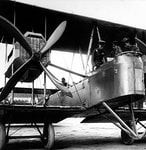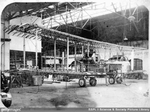Navigation
Install the app
How to install the app on iOS
Follow along with the video below to see how to install our site as a web app on your home screen.
Note: This feature may not be available in some browsers.
More options
You are using an out of date browser. It may not display this or other websites correctly.
You should upgrade or use an alternative browser.
You should upgrade or use an alternative browser.
WW1 aircraft
- Thread starter johnbr
- Start date
Ad: This forum contains affiliate links to products on Amazon and eBay. More information in Terms and rules
More options
Who Replied?Elvis
1st Sergeant
A bit off-topic, but here's an interesting picture...

According to the article, "Oswald Boelcke, (right) who is regarded as the father of the German fighter air force, shot down Robert Wilson (left), of the 32 Squadron Royal Flying Corps, before inviting him to join him for coffee."
From the days when Knights of the Sky was an apt title.
Here's the article - Oswald Boelcke shot down WWI British pilot then shook his hand and got him coffee | Daily Mail Online
Elvis
P.S. - Interesting how Boelcke put it. He didn't "splash" or "kill" his opponent, but rather he "...forced him to land". Much like the plains Indians "counting coup", the idea was not so much to actually take one's life, but to simply take them out of the competition at that particular point in time.
A different way of thinking.
In this day of general craziness happening in the world, there's a life lesson to be learned in that turn of phrase.
According to the article, "Oswald Boelcke, (right) who is regarded as the father of the German fighter air force, shot down Robert Wilson (left), of the 32 Squadron Royal Flying Corps, before inviting him to join him for coffee."
From the days when Knights of the Sky was an apt title.
Here's the article - Oswald Boelcke shot down WWI British pilot then shook his hand and got him coffee | Daily Mail Online
Elvis
P.S. - Interesting how Boelcke put it. He didn't "splash" or "kill" his opponent, but rather he "...forced him to land". Much like the plains Indians "counting coup", the idea was not so much to actually take one's life, but to simply take them out of the competition at that particular point in time.
A different way of thinking.
In this day of general craziness happening in the world, there's a life lesson to be learned in that turn of phrase.
Last edited:
Apparently it wasn't an uncommon occurrence, for the two enemy pilots to get together before the military police turned up to take the downed pilot away.A bit off-topic, but here's an interesting picture...
View attachment 495339
According to the article, "Oswald Boelcke, (right) who is regarded as the father of the German fighter air force, shot down Robert Wilson (left), of the 32 Squadron Royal Flying Corps, before inviting him to join him for coffee."
Here's the article - Oswald Boelcke shot down WWI British pilot then shook his hand and got him coffee | Daily Mail Online
Elvis
1st Sergeant
Definitely a more gentlemanly attitude.
We could all learn something from that.
Elvis
We could all learn something from that.
Elvis
Elvis
1st Sergeant
...more pics from that article...



Nice shots guys!
The a/c of Ltn. Paul Erbguth, Jasta 30.
- Thread starter
- #152
johnbr
2nd Lieutenant
- Thread starter
- #153
johnbr
2nd Lieutenant
Last edited:
- Thread starter
- #155
johnbr
2nd Lieutenant
Good shots guys!
- Thread starter
- #158
johnbr
2nd Lieutenant
The Vimy was the first twin-engined bomber built by Vickers and it became famous for the historic fligh by Alcock and Brown who became the first men to fly the Atlantic non-stop.
The prototype (B9952) was conceived and designed by Vickers Chief Designer Reginald Kirshaw Piersonwithin four month and flew at Joyce Green, Kent on 30th November 1917.
Four prototypes were built and trialled with different engines (Hispano Suiza, Salmson, Sunbeam Maori, Fiat, Hispano and Rolls-Royce Eagle), with the production FB27A Vimy II using the Rolls-Royce Eagle VIII engines.
The first Vickers FB.27 went to Martlesham Heath for official trials in January 1918 where it caused a sensation by lifting a payload heavier than its main competitor, the Handley Page 0/400 which boasted almost twice the power. Unfortunately the Vimy was beset with engine problems and had to be returned to Joyce Green earlier than expected where a number of alternative powerplants were tried.
Unfortunately the type was too late to see Operational Service and, despite a large numbers of Vimy's being ordered, sadly many of the contracts were subsequently cancelled after the Armistice. The prototype survived and it was flown to Amsterdam in August 1919 to take part in the Vickers display at the E.L.T.A. exhibition.
In total, Vickers built 147 aircraft at Bexleyheath, Crayford and Weybridge with further construction contracts being placed with a number of other suppliers including: Clayton & Shuttleworth Ltd; Kingsbury Aviation Co.; Metropolitan Wagon Co.; Morgan & Co.; The Royal Aircraft Factory, Farnborough and Westland Aircraft Works (Branch of Petters Ltd). Over 1,000 aircraft were ordered under wartime contract but in the confusion of cancelled orders and unfinished aircraft, the total actually delivered is still uncertain although it appears to have been in excess of 230.
In addition to a short-lived role as a torpedo bomber, many speculate that there was consideration given to fitting the aircraft with floatation devices although no evidence appears to exist of such a project.
There can be little doubt however that the Vimy would have had an important part to play in the First World War had it continued beyond 1918.
After the war, the type revealed its true capability with long distance, record-breaking flights. These included the famous first direct, non-stop Trans-Atlantic flight of Captain John Alcock (DSC) and Lt. Arthur Whitten-Brown (14th - 15th June 1919) when they flew from Newfoundland to County Galway, thus winning the £10,000 prize offered by the Daily Mail.
Later that year Ross and Keith Macpherson-Smith flew from England to Australia in G-EAOU between 12th November and 10th December 1919.
In addition to the Allcock & Brown Trans-Atlantic aircraft rebuilt and donated to the Science Museum in London, three full-size replicas have been created. The most well-known is the Vintage Flying Association aircraft at Brooklands (G-AWAU) although this is now in storage following display at The RAF Museum, Hendon during 2014.
Its potential of the Vimy as a military type is clearly demonstrated by its subsequent developments which included the following types: Vimy Commercial (44), Vernon (55), Virginia (126), Victoria (97) and Valentia (28).
Vimy Commercial
Vickers Vimy Commercial Variant K-107
The Vimy Commercial project saw an enlarged diameter fuselage aircraft take off on its maiden flight at Joyce Green on 13th April 1919. Although the prototype later entered the London-Cape Town Air Race in 1920, it was lost in a crash over Tanganika in February 1920.
Twenty aircraft were converted to bombers and saw service in both the first and second Zhili-Fengtian War in China during 1922. The Chinese order a hundred aircraft although only forty aircraft were eventually assembled, the balance remaining in their crates unused.
Fifty-Five military transport versions of the Commercial were built for the RAF, entering service under the designation Vickers Vernon.
Variants
F.B.27 Vimy
4 Prototypes built
Initially powered by two 200hp Hispano-Swiza piston engines although a number of alternative engines were trialled.
F.B.27a Vimy II
4 Prototypes built
Production variant for the RAF. Heavy-bomber with two Rolls-Royse Eagle VIII piston engines
Vimy Ambulance
Air Ambulance conversion for the RAF
Vimy Commercial
Initially conceived as a civillian transport aircraft, powered by two Rolls-Royce Eagle VIII engines, later variants were produced in bomber configurations and introduced into RAF servive as the Vernon
A.N.F Express Les Mureaux A one-off conversion for the French aircraft manufacturer
Specification (FB27a Vimy II)
Powerplant
Two 360hp Rolls-Royce Eagle VIII
Span
68ft 0in
Maximum Weight
12,500 lb
Capacity & Armament
Pilot and two gunners. Two Lewis guns and 2,476lb bomb load
Maximum Speed
103 mph
Endurance
11 hours
Attachments
Elvis
1st Sergeant
Wasn't the Fokker D.VIII a post war aircraft?
Wasn't the Fokker D.VIII a post war aircraft?
The Fokker D.VIII among other planes of the Jasta 6 in 1918...
Users who are viewing this thread
Total: 1 (members: 0, guests: 1)



